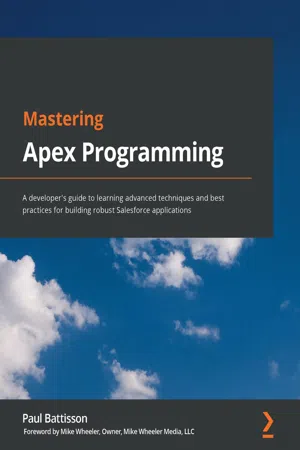
Mastering Apex Programming
A developer's guide to learning advanced techniques and best practices for building robust Salesforce applications
Paul Battisson
- 368 pages
- English
- ePUB (adapté aux mobiles)
- Disponible sur iOS et Android
Mastering Apex Programming
A developer's guide to learning advanced techniques and best practices for building robust Salesforce applications
Paul Battisson
À propos de ce livre
Get to grips with the advanced features of Apex programming for Salesforce developers using this comprehensive guide
Key Features
- Discover how to build reliable applications with Apex by avoiding common mistakes and pitfalls
- Learn how to use the different asynchronous programming tools in Apex
- Profile and improve the performance of your Apex code
Book Description
As applications built on the Salesforce platform are now a key part of many organizations, developers are shifting focus to Apex, Salesforce's proprietary programming language. As a Salesforce developer, it is important to understand the range of tools at your disposal, how and when to use them, and best practices for working with Apex. Mastering Apex Programming will help you explore the advanced features of Apex programming and guide you in delivering robust solutions that scale.
This book starts by taking you through common Apex mistakes, debugging, exception handling, and testing. You'll then discover different asynchronous Apex programming options and develop custom Apex REST web services. The book shows you how to define and utilize Batch Apex, Queueable Apex, and Scheduled Apex using common scenarios before teaching you how to define, publish, and consume platform events and RESTful endpoints with Apex. Finally, you'll learn how to profile and improve the performance of your Apex application, including architecture trade-offs.
With code examples used to facilitate discussion throughout, by the end of the book, you'll have developed the skills needed to build robust and scalable applications in Apex.
What you will learn
- Understand common coding mistakes in Apex and how to avoid them using best practices
- Find out how to debug a Salesforce Apex application effectively
- Explore different asynchronous Apex options and their common use cases
- Discover tips to work effectively with platform events
- Develop custom Apex REST services to allow inbound integrations
- Build complex logic and processes on the Salesforce platform
Who this book is for
This book is for Salesforce developers who are interested in mastering Apex programming skills. You'll also find this book helpful if you're an experienced Java or C# developer looking to switch to Apex programming for developing apps on the Salesforce platform. Basic Apex programming knowledge is essential to understand the concepts covered.
Foire aux questions
Informations
Section 1 – Triggers, Testing, and Security
- Chapter 1, Common Apex Mistakes
- Chapter 2, Debugging Apex
- Chapter 3, Triggers and Managing Trigger Execution
- Chapter 4, Exceptions and Exception Handling
- Chapter 5, Testing Apex Code
- Chapter 6, Secure Apex Programming
Chapter 1: Common Apex Mistakes
- Null pointer exceptions
- Bulkification of Apex code to avoid Governor Limits
- Hardcoding references to specific object instances
- Patterns to deal with managing data across a transaction